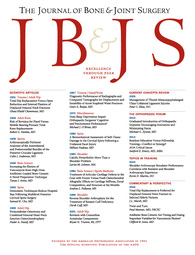
SHOULDER & ELBOW
Comparing PAI liposomal bupivacaine and ISBPB for postoperative analgesia following TSA
This report has been verified
by one or more authors of the
original publication.
J Bone Joint Surg Am. 2017 Apr 5;99(7):550-556
156 patients scheduled for total shoulder arthroplasty were randomized to postoperative analgesia through either intraoperative periarticular injection of liposomal bupivacaine or preoperative single-shot interscalene brachial plexus block (ISBPB). Patients were assessed for perioperative morphine equivalent unit consumption and pain severity scores over the first 24 hours postoperatively. Intraoperative morphine equivalent unit consumption was significantly greater in the PAI liposomal bupivacaine group compared to the ISBPB group, while postoperative morphine consumption did not significantly differ between groups. Additionally, pain scores were significantly higher in the PAI liposomal bupivacaine group compared to the ISBPB group immediately after surgery and at 8 hours postoperatively, whereas pain scores at 24 hours were significantly lower in the PAI liposomal bupivacaine group compared to the ISBPB group.
Unlock the full ACE Report
You have access to {0} free articles per month.Click below to unlock and view this {1}
Unlock NowCritical appraisals of the latest, high-impact randomized controlled trials and systematic reviews in orthopaedics
Access to OrthoEvidence podcast content, including collaborations with the Journal of Bone and Joint Surgery, interviews with internationally recognized surgeons, and roundtable discussions on orthopaedic news and topics
Subscription to The Pulse, a twice-weekly evidence-based newsletter designed to help you make better clinical decisions
Exclusive access to original content articles, including in-house systematic reviews, and articles on health research methods and hot orthopaedic topics
Or upgrade today and gain access to all OrthoEvidence content for just $1.99 per week.
Already have an account? Log in


Subscribe to "The Pulse"
Evidence-Based Orthopaedics direct to your inbox.
{0} of {1} free articles
Become an OrthoEvidence Premium Member. Expand your perspective with high-quality evidence.
Upgrade Now













































































